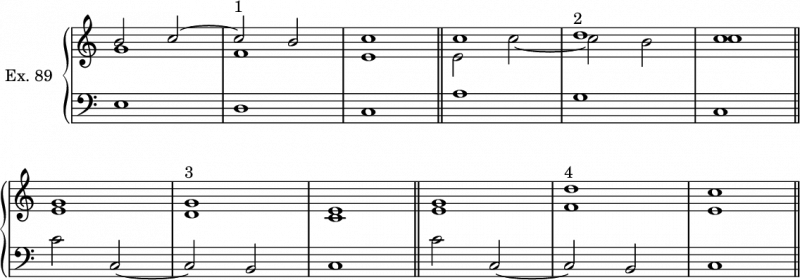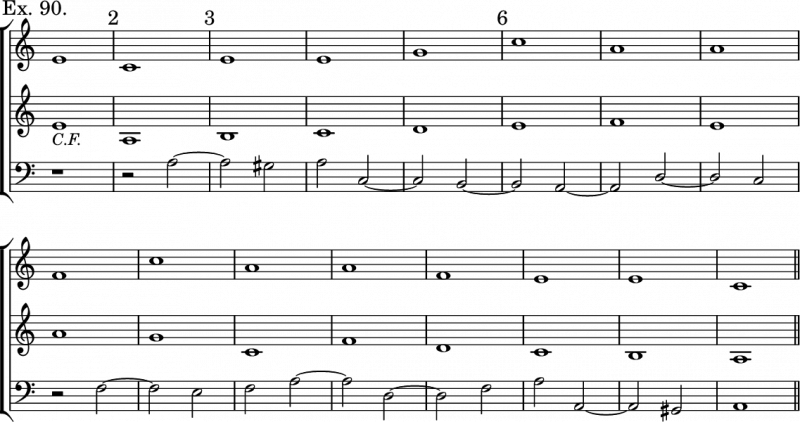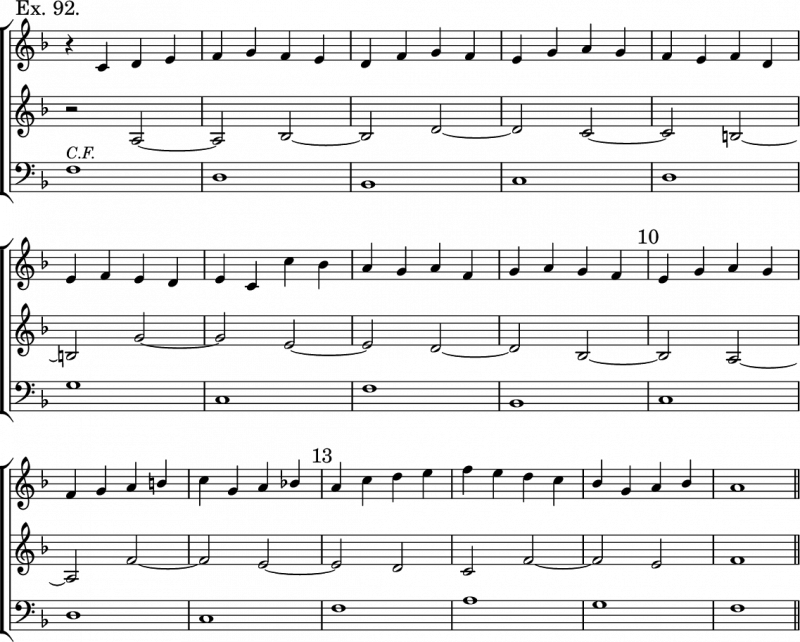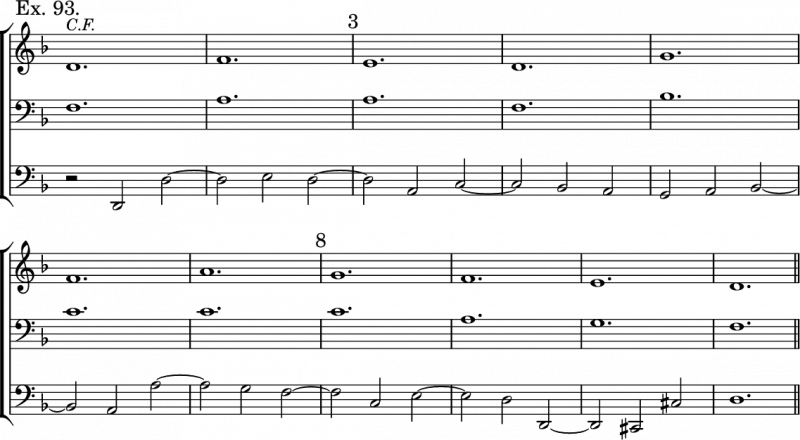Counterpoint (Bridge): Chapter 9
Fourth Species in Three Parts
Syncopation
Rules 1-5
The rules for this species in two parts apply generally in three parts. The additional part will be in notes of equal value with the cantus firmus, forming with it and the resolution of each syncopation either a triad or chord of the sixth. Care must be taken that the note, or its octave, the appearance of which is delayed by a suspension, does not occur in another part during the suspension. The ninth suspending the octave is of course an exception to this rule.
All the dissonances used in the corresponding species are available.
The fourth will be accompanied by the fifth or octave, and will resolve on the third.
The fifth (as a retardation) will be accompanied by the third, and will resolve on the sixth.
The seventh by the third (sometimes by the octave, particularly when it is a minor seventh), resolving on the sixth.
Rules 6-10
The ninth by the third, resolving on the octave.
Occasionally the sixth must be treated as a discord 1), as in, when it is clearly a suspension of the fifth.
We may also suspend the third in a chord of the sixth (by a fourth), and the octave in a chord of the sixth (by a ninth), but the effect is not always good, and the syncopations given above should be preferred.
The dissonances already mentioned occur in one of the upper parts only.
The dissonance of the second will be accompanied by the fourth or fifth, and occurs only in the bass. 2)
Rules 11-14
The syncopation may be broken, as in the corresponding species in two parts, and the second species may be interpolated, or even a rest introduced. This should not be longer than half a bar, unless at the commencement, when an additional bar's rest may sometimes be necessary to enable us to begin with syncopation on the second half of the second bar.
Passages involving hidden consecutives 3) must be avoided, even if they occur between the inner and one of the extreme parts.
The rule which requires a concord 4) to prepare a syncopation may be dispensed with if the bass remains stationary for two or more bars (Ex. 88, b). This “pedal”, as it is termed, is best when used just previus to the cadence, the dominant being sustained in the bass, although it may be effectively introduced in other places. The first discord 5) on a pedal must, however, be prepared as usual by a concord 6), and the last must also resolve on a concord.
During a pedal the part next above the bass may be dissonant with it (see Ex. 88, a); but it must be borne in mind that this part, during the continuance of the pedal, is after all the real bass, and the laws of strict counterpoint hold good between it and the upper part or parts.
The cadences are as follows:
This species may be written in triple meter as in two-part counterpoint, and the second or third species may also be combined with this (see Ex. 92).
Musical Examples
Observations on Examples 90-94
Ex. 90: The cantus firmus commences on the dominant, rendering the progression to bar 2 somewhat awkward, if the syncopation commence as usual in bar 1. Advantage has been taken of rule 11 7), the syncopation entering on the second half of bar 2. In bar 3 the dissonance of the second is accompanied by a fifth, in bar 6 the same dissonance is accompanied by a fourth.
Ex. 91: In bar 2 the sixth may be looked upon as a suspension of the fifth. In bar 11 the fifth is a retardation of the sixth.
Ex. 92: The third and fourth species are combined here. In bars 10 and 13 the fifth is taken by skip, against the seventh suspending the sixth. As will be seen in four-part counterpoint, the fifth often appears as an accompaniment to a suspended seventh.
Ex. 93: An example in triple meter. In bars 3 and 8 the suspensions are resolved ornamentally (as discussed in Chapter 5). 8)
Ex. 94: In bars 3 and 5 occur the somewhat unusual suspensions of a ninth and fourth on a chord of the sixth, alluded to in rule 8. 9) In bars 7 and 8 a “pedal” is used.
| Navigation | ||
|---|---|---|
| « Chapter 8 | Contents | Chapter 10 » |





